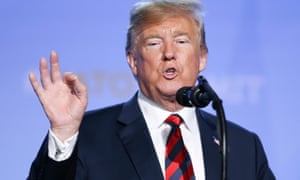Extract from The Guardian
The US president turned up late for Nato meeting, with an agenda that would stun many
The
first indication that things were not going to plan on the final day of
Nato’s summit came from a group of Romanian journalists. They had left
the main newsroom to observe a meeting between Donald Trump and the
Romanian president, Klaus Iohannis.
They returned to report that the meeting had been scrapped. Further reports began to spread around the newsroom. An earlier meeting between Trump and the leader of Azerbaijan had also been cancelled. So too had one planned with the leader of Ukraine. And Georgia.
Something was up. And that something was Trump, who, ever unpredictable, had gone on a diplomatic rampage, throwing long-prepared Nato plans into chaos.
On Wednesday night Nato leaders had begun to hope the worst was behind them. Trump had hours earlier delivered a rant against Germany, accusing it of failing to pay enough on defence and becoming a “captive” of Russia by allowing itself to become too dependent on Russian energy supplies.
Later the same day he had sounded calmer and more emollient during a series of private meetings, particularly over dinner with the other leaders. “I have to tell you that the atmosphere last night at dinner was very open, was very constructive and it was positive,” the president of Croatia, Kolinda Grabar-Kitarović, told reporters on Thursday morning.
The agenda for Thursday seemed, on the surface, to offer little
reason for further confrontation with Trump: a routine discussion of
moves by Georgia and Ukraine to join Nato and of Nato involvement in
Afghanistan.
It began on time, at 8.45am. Theresa May, Angela Merkel, Emmanuel Macron and other leaders were there. But Trump was missing.

They returned to report that the meeting had been scrapped. Further reports began to spread around the newsroom. An earlier meeting between Trump and the leader of Azerbaijan had also been cancelled. So too had one planned with the leader of Ukraine. And Georgia.
Something was up. And that something was Trump, who, ever unpredictable, had gone on a diplomatic rampage, throwing long-prepared Nato plans into chaos.
On Wednesday night Nato leaders had begun to hope the worst was behind them. Trump had hours earlier delivered a rant against Germany, accusing it of failing to pay enough on defence and becoming a “captive” of Russia by allowing itself to become too dependent on Russian energy supplies.
Later the same day he had sounded calmer and more emollient during a series of private meetings, particularly over dinner with the other leaders. “I have to tell you that the atmosphere last night at dinner was very open, was very constructive and it was positive,” the president of Croatia, Kolinda Grabar-Kitarović, told reporters on Thursday morning.
It began on time, at 8.45am. Theresa May, Angela Merkel, Emmanuel Macron and other leaders were there. But Trump was missing.

Seldom keen on such detailed discussions, the US president turned up late and came with a different agenda.
Ignoring the discussion about Georgia and Afghanistan, Trump charged forward, saying his predecessors in the White House had pushed for an increase by Europeans on defence spending and he was not going to put up with it. Dispensing with the usual diplomatic niceties, he pointed at Merkel, whom he dislikes on a personal level as well as over their policy differences, and said: “You, Angela.”
The most stunning comment came from a source reported by Reuters: “He said they must raise spending by January 2019 or the United States would go it alone.”
This was greeted with shocked silence. It had seemed unthinkable: a US president threatening to pull out of a military alliance that the US has regarded as a cornerstone of its military strategy for 69 years.
No one appears to be disputing the words. What is being disputed is the interpretation. Reuters reported Trump as having threatened to quit Nato but then rescinded this. Macron insisted this had not been Trump’s meaning.
But just as alarming was the apparent ultimatum. European leaders who have so far failed to reach Nato’s 2% defence spending target are talking about achieving this years from now, not by January.
Responding to the rising sense of panic in the room, the Nato secretary general, Jens Stoltenberg, called an emergency meeting. The leaders of Afghanistan and Georgia were asked to leave as they were not Nato members. The US president’s demand for further discussion of spending took precedence over Ukrainian and Georgian accession to Nato and the Afghanistan government’s fight with the Taliban.
The meeting then broke up, without Stoltenberg or any of the other European leaders offering a single concession.
A series of press conferences with European leaders had been scheduled but were cancelled as the leaders quickly headed straight for the airport. Downing Street insisted May had never intended to hold a press conference, even though one with her was being trailed on Nato’s internal television network, complete with location and time, and some journalists had headed over to the briefing room.
At the press conference, he hailed the summit as a success, praised Nato, insisted his relationship with other Nato leaders was good and – though other European leaders later disputed this – that they had agreed to significant increases in spending.
Trump, soon after leaving Brussels, tweeted a short video of the highlights of the Nato summit, which suggested a parallel universe in which the meeting had been a total success: flags, motor cavalcades, greeting Stoltenberg, sitting in amiable discussion with other leaders and standing together for the group picture, and a final wave at the press conference.
There were no rants about defence spending. In short, it had been a triumph. Attached to the video, he wrote: “Thank you @Nato2018!”

No comments:
Post a Comment